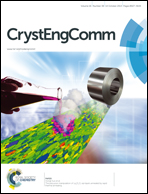Crystal structure of phosphonium carboxylate complexes. The role of the metal coordination geometry, ligand conformation and hydrogen bonding†
Abstract
A series of new mononuclear and heteronuclear complexes of carboxylate phosphonium betaines with biologically important metals (Zn(II), Cd(II), Hg(II) and Cu(II)) were obtained in aqueous media at ambient temperature. X-ray single crystal diffraction showed that carboxylate phosphonium betaines exhibit versatile complexation abilities, producing monomeric, dimeric and tetrameric homonuclear and mixed metal complexes. The binding mode was found to change in the series of Zn(II), Cd(II) and Hg(II) complexes with an increase of the cation radius. Water and chlorine atoms, bound to the metal, play an important role in crystal formation. In the case of α- and β-substituted phosphabetaines, the crystallization of various stereoisomers was observed including a rare case of co-crystallization of two diastereomers in one crystal.


 Please wait while we load your content...
Please wait while we load your content...